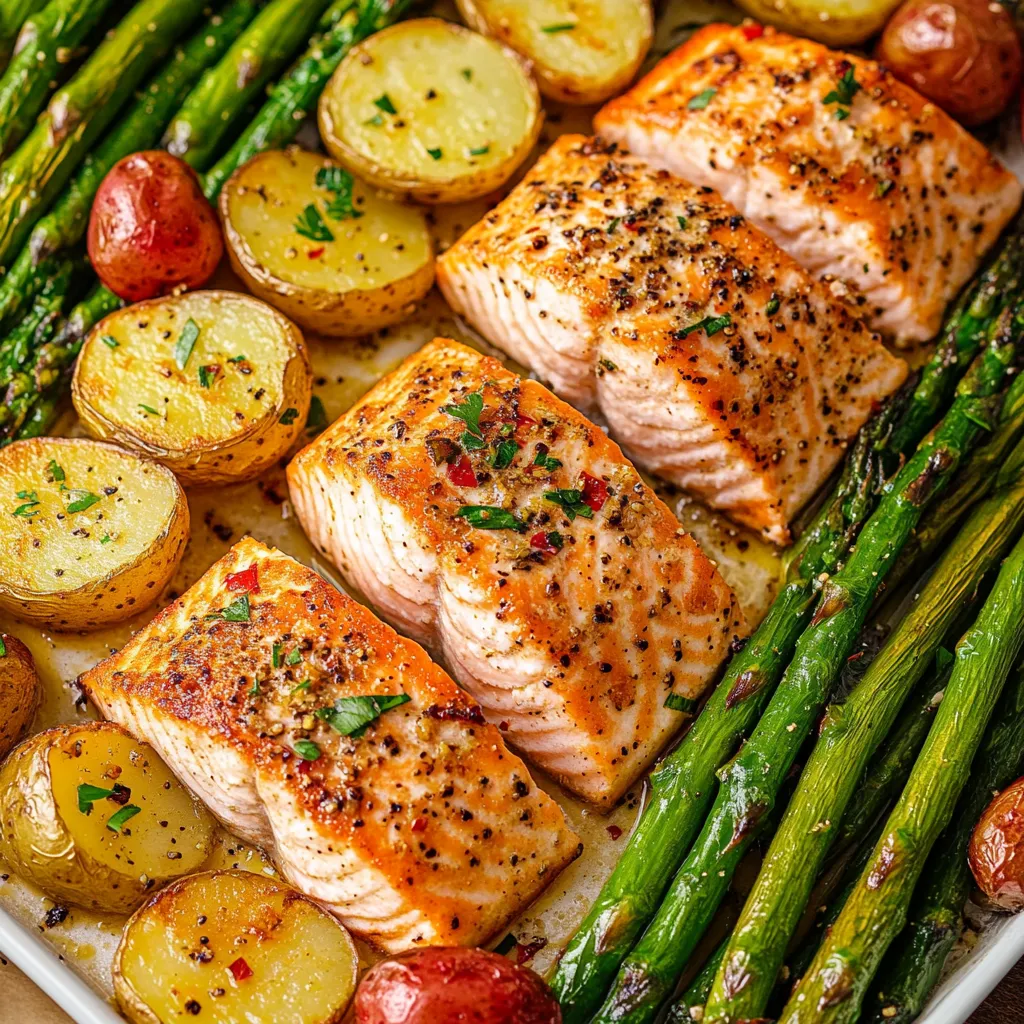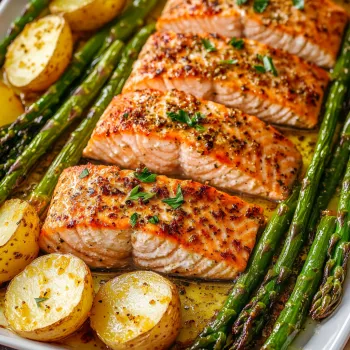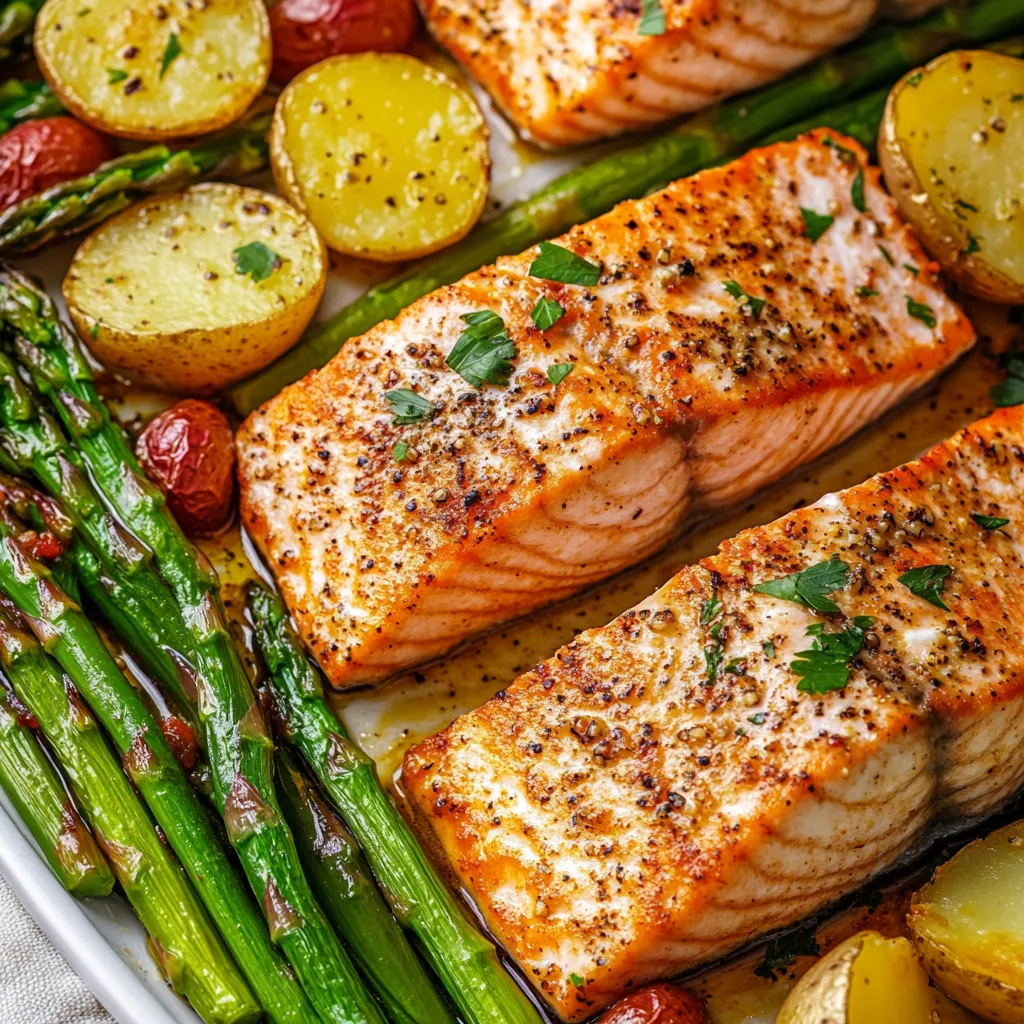 Pin it
Pin it
I stumbled onto this meal during an incredibly hectic time, and now it's what I make when I want something fancy but don't have all night to cook. The way the sweet-tangy glaze browns up on the fish always wows anyone I'm feeding.
Key Ingredients and Smart Shopping Advice
- Salmon Fillets: Try to get pieces that are the same thickness so they cook evenly. Wild salmon tastes best, but farmed works fine too.
- Baby Potatoes: Go for ones that are roughly the same size for even cooking. The red or gold ones keep their shape really well.
- Fresh Asparagus: Look for bright green stalks with tight tips. The thicker ones actually work better with this cooking method.
- Dijon Mustard: Grab whole-grain or smooth Dijon for the right flavor. Don't use yellow mustard - it's way too sour.
- Quality Butter: Get unsalted so you can control how salty your glaze is.
- Fresh Lemon: Pick ones that feel heavy for their size to get the most juice.
Foolproof Timing Tips
- Step 1: Give Your Potatoes a Head Start
- Chop potatoes into same-sized chunks so they cook evenly. Mix them really well with oil and seasonings. Lay them out so they aren't touching each other. Let them cook alone for those crucial first 10 minutes.
- Step 2: Whip Up the Best Glaze
- Melt your butter gently so it doesn't break. Mix in honey and mustard until it's totally smooth. Throw herbs in at the end to keep their flavor strong. Keep it warm until you need it.
 Pin it
Pin it
After making this countless times, I've realized that how you arrange everything on the pan really matters. Putting the salmon in the middle with veggies around the edges makes everything cook just right. My mom always told me, 'Everything needs room to breathe on the pan,' and she wasn't kidding.
Understanding Your Sheet Pan's Hot Spots
I've noticed that different parts of a sheet pan don't heat the same way. The edges get hotter, which makes them perfect for getting those potatoes extra crispy, while the middle heat is gentler for the salmon. Knowing these hot spots helps make everything turn out perfectly.
Getting That Perfect Glaze
The honey-mustard mixture isn't just a topping - it's what makes this dish amazing instead of just okay. I've found that putting it on twice - once before cooking and again halfway through - gives you that beautiful browning without burning anything.
Rounding Out Your Meal
While this dish is great by itself, I often add simple sides to make it feel like a complete meal. A quick green salad with lemony dressing or some warm bread makes dinner feel extra special without adding any real work.
 Pin it
Pin it
This one-pan salmon and asparagus has become more than just another dish I make - it's my go-to when I want something impressive without spending hours cooking. Whether you're feeding your family or having friends over, it gives you restaurant-quality food with minimal effort. The combo of perfectly cooked salmon, crispy potatoes, and tender asparagus makes a complete meal that's both satisfying and a bit fancy. Just remember, great sheet pan dinners are all about timing and temperature. Pay attention to how your oven behaves, adjust as needed, and you'll end up with a perfectly coordinated meal every single time.
Frequently Asked Questions
- → Can I cook this with frozen salmon pieces?
- Sure, just make sure they're fully thawed and dabbed dry with kitchen paper before cooking so they brown nicely and cook evenly.
- → How can I tell when the salmon's ready?
- The salmon should break apart easily with a fork and have a light pink center, usually after about 15 minutes in the oven.
- → Is this good for making ahead?
- Absolutely, it stays fresh in the fridge up to 3 days. Warm it up in the oven for the best texture.
- → What can I use instead of asparagus?
- Try fresh green beans, broccoli florets, or halved Brussels sprouts. Just tweak the cooking time for whatever veggie you pick.
- → Why should I cut my potatoes into quarters?
- Quartered potatoes cook quicker and get nice crispy edges while staying soft inside, finishing at the same time as your salmon.
